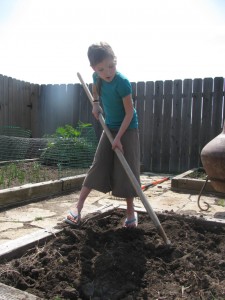I think everyone should have a garden, so I talk about it all of the time. It must be working; my girlfriends are now gardening with their families. They are shopping the garden centers, sending me texts, calling me over to show what’s blooming and I LOVE IT! Let’s admit it, gardening is hot right now!
 This is the year, roll up your sleeves, grab the kiddo’s and start the garden you have been talking about for years. Oh, but I can’t grow anything. Yes, you can! I will be the first to admit, I have killed my fare share of plants (carrots are my nemesis; we have the hardest time getting them to germinate!) The biggest mistake you will make is NOT starting. We all have to start somewhere.
This is the year, roll up your sleeves, grab the kiddo’s and start the garden you have been talking about for years. Oh, but I can’t grow anything. Yes, you can! I will be the first to admit, I have killed my fare share of plants (carrots are my nemesis; we have the hardest time getting them to germinate!) The biggest mistake you will make is NOT starting. We all have to start somewhere.
If you already have a garden, read along, I’m sure there is something you can gain from today’s blog. If I’ve missed an ingredient to success, please let me know!
The very basics to starting a garden:
1. Location, Location, Location: Find a sunny spot. A successful garden needs 6 hours of sunlight! You may also consider protection from the wind. That wind can knock down a new seedling pretty quickly. Make it easy to keeps plants watered, by locating your garden close to the water source.
2. Determine what your plants will grow in. It can be pots on a deck, a raised bed or simply a spot cultivated in your yard. Let me encourage you to start small. It’s much easier to manage a small garden plot and keep the weeds under control than have a large weedy mess. I have seen too many beginning gardeners, till up more than they can handle. Make it manageable and you will be successful.
3. Soil test! Soil is the main ingredient for a successful gardening experience. You can do everything else right and foil a good garden plan with poor soil. Take the time to do it right the first time. A healthy garden bed is composed of an even mix of top soil, compost and nutrients. I have found that this combination provides good drainage and is easy to work with. As your plants begin to grow they will absorb the nutrients in the soil, which can be replenished with the addition of more organic matter or fertilizer.
4. Let the fun begin. Plant what you are going to eat! I also like to find something new, last year we planted purple potatoes, and they were a huge hit with my three girls.
5. They are alive!! Your garden needs your attention. Don’t forget to water, weed, fertilize and love!






What’s the best/least expensive way to test soil? If I only have one garden area, how can I make plants that require different things happy?
Becky, Great question! Stay tuned, it’s covered in the next blog.
With the soil, what if you are going to start fresh with top soil/compost/nutrients from the garden center. Suggestions on what we should get?
Lisa, I can’t give you specific brand names. My best advice is to go to a local garden center, not a box store, find a staffer that has dirt under his/her nails. Ask them which soil products they recommend for a new gardener. If you are putting in a large raised bed it may get very expensive buying bag after bag of top soil and compost. The local paper classified section will have ads for topsoil and compost. Most likely you can get a pick up load at a reasonable price. As your plants grow nutrients are consumed by the plant and additional fertilizer will need to be added.
We close on our house tomorrow and I am planning on doing a raised bed. Do I need to do anything with the grass underneath before I do the raised bed. I’m planning on getting one of those board kits from a place like home depot or lowes.
Kate,
Congratulations on your new home! Adding a garden is a great start to making a house a home. You could till up the soil or apply a grass killer to the area where the garden will go. If you are going to add a thick layer of topsoil and compost to your raised bed, killing the grass may not be necessary.